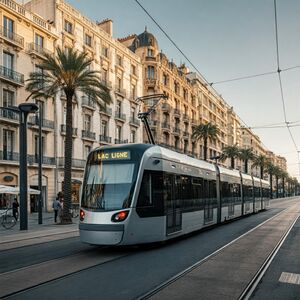Albonne
Script error: The module returned a nil value. It is supposed to return an export table.
Albonne | |
|---|---|
Provincial Capital City | |
 Skyline of the business center of Albonne | |
| Etymology: toward good(ness) | |
| Nickname: Northern Phoenix | |
| Nation | |
| Country | |
| Province | Lacliona |
| Elevation | 1,373 m (4,505 ft) |
| Population (2035) | |
| • Total | 258,403 |
| Demonym | Albonneise |
| Website | www.albonne.gouv |
Albonne is a Burgoignesc city located on the northeastern shore of Lac Liona. It is the capital of Lacliona Province, in northwestern Faramount, in the Burgoignesc Metropole. Albonne is a global city, a financial center, and a worldwide center for diplomacy due to the presence of numerous international organizations, including the headquarters of some agencies of the League of Nations. Albonne hosts one of the highest numbers of international organizations in the world. It is geographically considered part of the Upland but is culturally more associated with the Metropolitans.
Historically it was the site of the siege and sack of Arbonne during the Great Confessional War and the First and Second Battle of Arbonne during the Second Fratricide. The city has been leveled multiple times throughout its history and has a tradition of reinventing itself each time it recovers to become more economically viable in the new era. As such its symbol is the Phoenix.
History

Prehistory
Evidence of human presence in Albonne dates back to prehistory, with traces of the oldest huts built by nomadic hunters, around 300,000 years ago. The stratigraphy showed different settlement periods, with the remains of oval huts with a central hearth, chipped pebbles, scrapers and captured animals such as wild boar, turtles, {wp|Merk's rhinoceros}}, aurochs and various birds. Traces of Neanderthals have also been found. Signs of frequentation dating back to the end of the Upper Palaeolithic are visible and there is evidence of Neolithic and epigravettian strata dating between 20,000 and 18,700 years ago, and human remains have been found dating back as far as 7,000 BC.
Classical Antiquity
Medieval period
Siege and sack of Albonne
Albonne was part the Holy League.
Early modern history
First Caroline War
Late modern period
Contemporary period
Geography and climate
Albonne is located at the high coastal plains on the northeastern shore of Lac Liona, situated at 1373m above sea level. It has a tropical climate, with average temperatures ranging from 25°C (77°F) to 30°C (86°F) throughout the year. The city receives an average of 2,000 millimeters (79 inches) of rainfall annually, most of which falls during the rainy season from May to October.
Government
The government of Albonne is mayor-council with a Castellan-Public and a Municipal council. The council members and mayor are elected using proportional representation every 5 years.
Economy and infrastructure
Albonne has a remarkably high standard of living, with its residents enjoying a level of prosperity and well-being that ranks among the highest in the world. This is due to a combination of factors, including a strong economy, a stable government, and a commitment to social welfare. Albonne's economy is driven by several sectors, including finance, tourism, and international organizations. The city is home to several major banks and financial institutions and has a thriving tourism industry specifically related to Lac Liona. Albonne is also a major center for international organizations, including agencies of the League of Nations, the World Health Organization, and the World Trade Organization. The city has a low unemployment rate, a high average income, and an average cost of living. The residents of Albonne also have access to high-quality healthcare, education, and housing. It is known for its high levels of academic attainment. The city has a well-developed education system, with a number of prestigious public and parochial schools. The city is also home to a number of universities, including the University of Albonne, which is one of the top universities in Burgundie.
Agriculture
Urban farming

Albonne, like most other Burgoignesc of hyper-urbanization cities, has had to embrace verticality and innovation to overcome its inherent spatial limitations when it comes to growing food within its limits. The Albonne's urban agriculture begins in the latter half of the 20th century. With its core and metropolitan area completely built out, every centimeter of land became precious. Faced with this constraint, Albonne's innovative spirit turned its gaze upwards, towards the vast expanse of unused flat rooftops of the post-modernist buildings being built. What were barren expanses became fertile gardens, bursting with life and providing fresh, locally-grown produce. These early rooftop farms were modest in scale, often relying on simple techniques and readily available materials. However, they served a dual purpose: not only did they address the city's growing food needs, but they also provided a clever solution to the challenges of a tropical climate. The gardens, flourishing during the rainy season, acted as natural coolants, mitigating the urban heat island effect and reducing energy consumption for cooling. As technology and architecture advanced, so too did the sophistication of Albonne's urban farms. Lightweight, durable materials reduced the burden on buildings, while innovative irrigation systems and hydroponics maximized efficiency. Greenhouses and shade structures were incorporated to create microclimates, allowing for the cultivation of a wider variety of crops. The dawn of the 21st century ushered in a new era of vertical farming in Albonne. Technological advancements enabled the construction of multi-story farms, integrated seamlessly into the urban fabric. These vertical farms, with their controlled environments and optimized growing conditions, boast significantly higher yields than traditional rooftop gardens. They utilize LED lighting, automated irrigation, and nutrient-rich solutions to create ideal growing conditions, regardless of external factors. From mangoes and passion fruit to everyday staples like tomatoes and leafy greens, these urban farms provide approximately 11% of the fruits and vegetables consumed locally. The benefits of Albonne's urban agriculture extend far beyond food production. It is more recently noting for contributing significantly to the city's sustainability goals, reducing transportation costs and associated carbon emissions, minimizing water consumption, and improving urban air quality.
Florideophyceae Cultivation

Lac Liona's tropical climate and pristine waters is a keen environment for the cultivation of Florideophyceae red algae. This industry became a cornerstone of the local economy during the siege of Albonne during the Great Confessional War, and is now renowned for its sustainability and high-quality products. Several species of Florideophyceae are grown in the warm, shallow waters of the lake, Gracilaria, Gelidium, and Pterocladia, all raised for their high agar content. Large-scale farms utilize floating rafts or submerged longlines to support the growing algae are the most common method of cultivation. This method allows for efficient use of space and minimizes impact on the lakebed. In shallower areas, algae are cultivated on nets or ropes attached to stakes driven into the lakebed. This method is often used by smaller farms and allows for easier monitoring and harvesting, but is decried as unsightly and is limited in scope. Some farms have even spent significant capital to combine algae cultivation with fish farming, creating a symbiotic system where fish waste provides nutrients for the algae, and the algae help to purify the water. There are 3,378 involved in the cultivation of Florideophyceae in Albonne.
Agribusiness

The Florideophyceae cultivated in Lac Liona are primarily processed into two main products: high-grade Albonneiese agar and high-quality soaps in manufactories on the outskirts of Albonne. The agar production process involves several steps after harvesting. Harvested algae is thoroughly cleaned to remove any debris and then dried in the sun or using specialized drying equipment. The dried algae is boiled in water, and the agar is extracted through a series of filtration and purification processes. The extracted agar is allowed to gel and then dried into sheets, flakes, or powder. Albonne's agar is highly sought after for its purity and quality. It is used in a wide range of food products, including desserts, confectionery, sauces, and dairy products. It also finds applications in the pharmaceutical and cosmetic industries. There are 9,530 people working in the agar production business.
Florideophyceae algae are also utilized in the production of natural soaps. The algae's high mineral content and natural gel-forming properties make it an ideal ingredient for creating gentle and moisturizing soaps. The soap-making process involves combining the algae extract with oils, such as coconut oil or olive oil, and a lye solution. This mixture is then saponified, resulting in a solid soap. Albonne's algae soaps are known for their creamy lather, moisturizing properties, and delicate natural fragrance. They are often enriched with other botanical ingredients, such as essential oils and herbs from Alcairet, and Chaukhira, to create a variety of luxurious and therapeutic products. There are 1,429 people in the soap making sector in Albonne.
Sports and sport teams
Albonne is a major center for sports, and the city hosts several international sporting events each year. The city is home to several professional sports teams, including the Albonne Phoenix Football Club, the Lacliona Basketballers, the Lakeshore Polo Team, the Phoenix Rugby Association, and the Upland Yacht Club. There are three stadiums in the metro area.
International organizations hosted in Albonne
- Centre de Analyse International d'Albonne- a INGO that does international opinion and political polling since the 1960s. It is most famous for its data collection as part of the Reunification of Kiravia
- Union of the Fourth Pareto- an international partnership of states and provinces in Burgundie, Lapody, and Rhotia who were part of the Fourth Pareto together and who stood strong against the concepts of Two Derics and refused to engage in the First Fratricide
Infrastructure


Albonne is a well-connected city with a modern transportation system. The city has an international airport, a public transportation system that includes buses, trams, and trains, and a network of roads and highways. The train service is provided by the Burgoignesc Rail Transportation Amenity through the inter-provincial services coming through Gare du Lac in the city center. Gare du Lac serves as a major transportation with a bus station, three commuter lines, and a light rail stop. Gare du Lac also serves as the host for two Strategic Auxiliary Fleet of the Continuation trains. The airport is Albonne International Airport with services to cities across the Burgoignesc Metropole and many major hubs in southern Levantia.
Port Lacliona
| Port Lacliona | |
|---|---|
 | |
| Location | |
| Country | |
| Location | Albonne, Lacliona, Faramount |
| Details | |
| Opened | 1637 |
| Operated by | Port Lacliona Operating Company |
| Owned by | Lacliona Port Authority |
| Type of harbor | Public-Private |
| Employees | 583 |
| Statistics | |
| Annual revenue | ₮2.2 million |
Port Lacliona was initially built in 1637 as part of the Bishop of Doilaghi's, Aiton-Feipo Pardio Bruzzone, attempts to capitalize his lakes as a trade route for goods from the Duchy of Martilles to the western interior of the Kingdom of Dericania and for grains, cereals, and timber from the interior to the Duchy of Martilles. Albonne was on a Latinic military road that had served as a trade route for centuries, but the rivers in the Duchy of Martilles bypassed the Bishopric of Doilaghi and as the colonies of the Duchy of Martilles expanded and became profitable, the Bishop Bruzzone wanted to become a part of the new trade boom. This port remained until 1797 when it was destroyed in the Second Caroline War by Kingdom of Dericanian forces. It was rebuilt throughout the early 1800s, but on a much smaller scale as the collapse of the Burgoignesc colonial empire had begun and trade wasn't what it once was. When it was completed in 1839 it was almost immediately outmoded by the rise of railroads. The First Fratricide and the use of rail for military purposes saw the port fall into disuse, and it was relegated to building and repairing fishing boats. From the 1850s through the 1930s, many rail freight companies used chain boats to supplement their rail lines, especially in areas of Upland mining communities where they had not yet built rail lines, or they were not deemed profitable. Port Lacliona became an industrial manufactory for these Chain boats with the Albonne Chain Boat Company and the O'Shea Hull Design were the two most prominent companies in this era.




